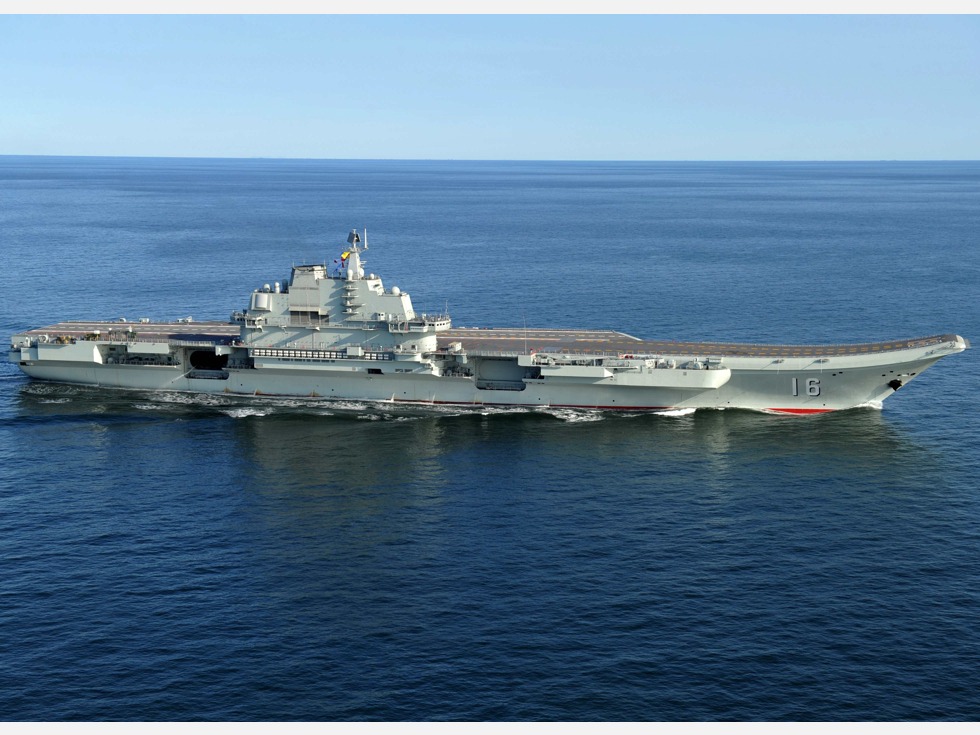
Carrier Operations on Display in the Bohai Gulf
Carrier Operations on Display in the Bohai Gulf
On December 15, the Chinese Navy put its first carrier, the Liaoning, through its paces in the Bohai gulf (渤海) near Tianjin and conducted its first exercise with live ammunition (CCTV, December 16). The ship’s complement of J-15 aircraft also carried out a series of tactics and weapons tests. Footage of their flight included the launch of a YJ-8 anti-ship missile against a target ship (CCTV, December 16, ref: 1:13). For the carrier itself the exercise tested a number of basic tasks for a carrier group, including reconnaissance and early warning, air interception, assault at sea, air defense and missile defense. Footage from the exercise showed the carrier launching Rolling Airframe (RAM) anti-air missiles and using its close-in-support weapon (CIWS) Gatling gun.
Carrier Aviation Group Commander Xu Ying (徐英) stated that the live fire exercise represented a “major advancement of [the pilots] tactical skills” (CCTV, December 16). Xu has apparently replaced Dai Mingmeng (戴明盟), the first pilot to land on the Liaoning and for which he was given the honorary title of “hero test pilot” (Xinhua, August 27, 2014). The Carrier Group Commander Chen Yueqi (陈岳琪) noted that this exercise was the Navy’s first combined (综合性; meaning, coordinated between both traditional surface combatants and the aircraft carrier) live-fire exercise and was acted as a test of the effectiveness of further exercises (CCTV, December 16).
This represents significant progress since last year, when Admiral Sun Jianguo, Commander of China’s Navy, observed air operations off its flight deck. At the time, Chinese pilots were still improving their carrier-landing skills, and television footage from the exercise showed J-15 fighter aircraft carrying blue dummy PL-9 and PL-12 air-to-air missiles (CCTV, December 25, 2015).
China plans to build at least three aircraft carriers, one for each of its three Fleets (North, East and South). China’s first indigenously produced aircraft carrier, currently designated 001A, is almost complete and will be launched before the end of December, possibly on December 26, Mao Zedong’s birthday (Sina, November 28). The new carrier incorporates a number of different design features from its Soviet predecessors, including a shifted axis flight deck and a different configuration of its “island” (the control tower rising from the flight deck). Popular military commentator Yin Zhuo noted that the new carrier could possibly incorporate Electromagnetic Aircraft Launch System (EMALS), a replacement for traditional steam catapults have a superior ability to tailor the launch speed for a range of different aircraft types, reducing wear on airframes and faster reset speed. While the success of weapons integration tests and modern technology could increase the new carriers’ combat power, its design will likely fall short of other modern carriers.
The 001A is expected to have a displacement of 50,000 tons (Guanchazhe, January 1). For context, this displacement is roughly half that of U.S. nuclear carriers like the USS Carl Vinson. A more likely comparison would be with the U.S. Navy’s Landing Helicopter Decks (LHDs), used to transport amphibious assault forces and provide limited close air support, or Japan’s 30,000-ton Izumo-class helicopter destroyer. Rather than the center-piece of power projection as it is in the U.S. Navy, China’s carriers are likely to act together with land-based air defenses and other naval vessels in defense, or in support of amphibious forces. A Chinese military textbook, the Science of Campaigns for example briefly mentions carriers in the context of supporting “operations in island and reef areas far from the mainland.” [1]
China has built up a system of artificial islands in the South China Sea, which analysts have recently confirmed now have weapons emplacements. China has previously deployed surface-to-air missiles to natural islands it occupies in the South China Sea including Woody Island (永兴岛), prompting its southern neighbor Vietnam to similarly begin upgrading its offshore island defenses (China Brief, March 28).
China’s speed in building its first indigenous carrier could be an indication that it wants to rapidly deploy forces to patrol the airspace over its territorial claims in the South China Sea. Its lengthy attempt to acquire Su-35 fighters from Russia, though typically depicted as due to a need for their superior engines, could also be motivated by their exceptional range. If acquired in sufficient numbers, the Su-35 would significantly bolster China’s ability to conduct long-distance maritime patrols like that which circled Taiwan in late November (China Brief, December 5).
As Russia’s experience in the Mediterranean, where the Liaoning’s sister ship, the Admiral Kuznetsov lost two aircraft to mishaps in the space of a month, carrier operations are difficult if not done consistently to build a core of experience pilots and maintenance crews.
The Chinese navy is slowly mastering basic naval operations that the U.S. Navy has performed globally for more than 50 years. But its progress is systematic, and Chinese military publications frequently point out the obstacles remaining to becoming a true “carrier navy.” However, to be a truly effective force in China’s regional waters, and leverage the fruits of China’s other weapons programs, the PLA Navy will need to coordinate more closely with the land-based aviation of the Air Force, the missile brigades of the Rocket Force and the C4ISR support and space/cyber capabilities of the Strategic Support Force. While such operations will certainly become more common as China strives to build a joint force, its current inexperience represents a real bottleneck for Chinese power projection or layered defenses.
Notes
- The Science of Campaigns (战役学), Zhang Yuliang, Chief Editor Beijing: National Defense University Press, May 2006
Peter Wood is the Editor of China Brief. You can follow him on Twitter @PeterWood_PDW


